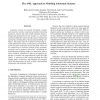176 search results - page 1 / 36 » Autonomicity of NASA Missions |
ICAC
2005
IEEE
13 years 10 months ago
2005
IEEE
NASA increasingly relies on autonomous systems concepts, not only in the mission control centers on the ground, but also on spacecraft, on rovers and other assets on extraterrestr...
ALIFE
2002
13 years 4 months ago
2002
A new approach called bioinspired engineering of exploration systems (BEES) and its value for solving pressing NASA and DoD needs are described. Insects (for example honeybees and ...
IGARSS
2010
13 years 2 months ago
2010
The NASA Soil Moisture Active Passive (SMAP) Mission will provide global observations of soil moisture and freeze/thaw state from space. We outline how priority applications contr...
MVA
1998
13 years 6 months ago
1998
Current NASA plans call for extended year-long, multikilometer treks for the 2003 and 2005 Mars missions. A much greater amount of rover autonomy is required compared to the recen...
ICAS
2006
IEEE
13 years 11 months ago
2006
IEEE
Autonomic systems are typically distributed, complex and concurrent systems, comprised of multiple interacting autonomic elements that often exhibit emergent behavior. Design and ...

